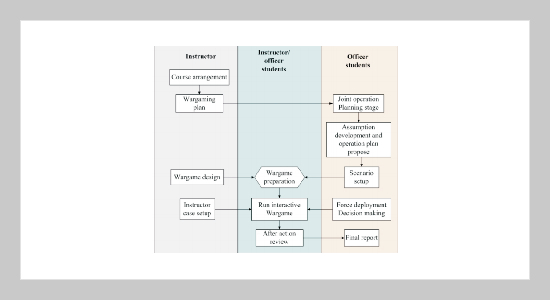Ming-Chih Tung1 , Jiung-Yao Huang This email address is being protected from spambots. You need JavaScript enabled to view it.2, Huan-Chao Keh3 and Shu-Shen Wai2
1Department of Computer Science and Information Engineering, Ching Yun University, Taoyuan, Taiwan 320, R.O.C.
2Deptartment of Computer Science and Information Engineering, National Taipei University, Taipei, Taiwan 237, R.O.C.
3Department of Computer Science and Information Engineering, Tamkang University, Tamsui, Taiwan 251, R.O.C.
REFERENCES
- [1] TRADOC, “The Army Distance Learning Program (TADLP) Campaign Plan”. United States Army Training and Doctrine Command, Training Development and Analysis Directorate, Fort Monroe, Virginia, September 2001. Retrieved Jan. 2, 2008 from the URL: http://www.tradoc.army.mil/tadlp/documents/ TADLP%20Campaign%20Plan%20SEP2001.pdf.
- [2] Schechter, T. M., Bessemer, D. W. and Kolosh, K. P., “Computer-Based Simulation Systems and Role-Playing: An Effective Combination for Fostering Conditional Knowledge,” Journal of Computer-Based Instruction, Vol. 19, pp. 110�114 (1992).
- [3] Roffe, I. “E-Learning: Engagement, Enhancement and Execution,” Quality Assurance in Education, Vol. 10, pp. 40�50 (2002).
- [4] Urdan, T. and Weggen, C. “Corporate E-Learning Exploring: A New Frontier,” Computer News, Vol. 53, pp. 35�36 (2000).
- [5] DUSD(R). “Department of Defense Strategic Plan for Advanced Distributed Learning,” Office of the Under Secretary of Defense for Personnel and Readiness, Department of Defense, Washington, DC, April 1999. Retrieved Jan. 26, 2008 from the URL: http://www .adlnet.gov/downloads/downloadpage.aspx?ID=256.
- [6] Taiwan Yearbook (2007) – National Defense, Retrieved Jan. 26, 2008 from the URL: http://www.gio .gov.tw/taiwan-website/5-gp/yearbook/08national% 20defense.html#09.
- [7] Peterson, J. L., “Petri Net Theory and the Modeling of Systems,” Englewood Cliffs, NJ: Prentice-Hall, Inc. (1981).
- [8] Huang, J. Y. and Deng, L. Y., “The Petri Net Model for the Collaborative Virtual Environment on the Web,” Tamkang Journal of Science and Engineering, Vol. 3, pp. 267�281 (2000).
- [9] Stapp, K. M. “Benefits and Costs of Distance Learning: A Perspective from the Distance Learning Literature since 1995,” White Sands Missile Range, NM, TRADOC Analysis Center, June 2001. Retrieved Feb. 10, 2008 from the URL: http://handle.dtic.mil/100.2 /ADA396197
- [10] Howard, F. S. “Distance Learning Annotated Bibliography,” White Sands Missile Range, NM, Department of the Army, TRADOC Analysis Center, June 1997. Retrieved Feb. 10, 2008 from the URL: http:// www.isn.ethz.ch/pubs/ph/details.cfm?v21=109329& lng=en&click53=109329&id=10236.
- [11] Metzko, J., Redding, G. A. and Fletcher, J. D. “Distance Learning and the Reserve Components,” Washington, DC, Institute for Defense Analyses (IDA), December 1996. (Doc. No. D-1941). Retrieved Feb. 10, 2008 from the URL: http://handle.dtic.mil/100.2/ADA 321230.
- [12] Bernard, R. M., Lou, Y., Abrami, P. C., Wozney, L., Borokhovski, E., Wallet, P., Wade, A. and Fiset, M., “How Does Distance Education Compare with Classroom Instruction? A Meta-Analysis of the Empirical Literature,” Review of Educational Research, Vol. 74, pp. 379�439 (2004).
- [13] Machtmes, K. and Asher, J. W., “A Meta-Analysis of the Effectiveness of Telecourses in Distance Education,” American Journal of Distance Education, Vol. 14, pp. 27�46 (2000).
- [14] Ramage, T. R., “The No Significant Difference Phenomenon: A Literature Review,” e-Journal of Instructional Science and Technology, Vol. 5. Available online at http://www.usq.edu.au/electpub/e-jist/docs/html 2002/ramage.html (2002).
- [15] Sanders, W. R. and Burnside, B. L., Assessment of initial delivery of the Armor Captain’s career course (distance learning). (Technical Report #1775, May 2001.). Alexandria, VA: US Army Research Institute for the Social and Behavioral Sciences (2001).
















